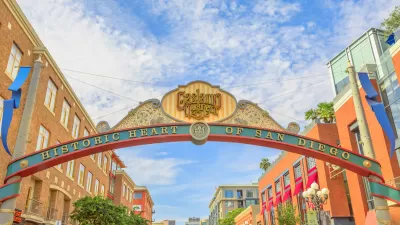Following a recent study finding quantifiable economic benefits for neighborhoods with a mix of older buildings, a writer describes the qualities of older buildings that makes the places they occupy feel so special.
F. Kaid Benfield examines the sources of value in old, or legacy, buildings. Before explaining just what and how older buildings and neighborhoods add to communities and cities, Benfield explains the assumptions of his argument: "the best of our older buildings and neighborhoods have a distinctiveness to them, almost by default."
Benfield describes two of the attributes of older place that add to the vitality of communities: continuity of place and cultural engagement. In the case of the former concept, a place that has managed to retain its original character and charms provides comfort in a quickly changing world. In the case of the latter concept, "[these] places are magical precisely because we have had little or no previous experience, no continuity, with them," writes Benfield.
Benfield also cites new research from the National Trust for Historic Preservation, also discussed in depth by an earlier article by Emily Badger, which "finds that established neighborhoods with a mix of older, smaller buildings perform better on a range of economic, social, and environmental metrics than do districts with larger, newer structures."
Before concluding, Benfield makes it clear that he does not resist change, but that change must be thoughtful—"change that…does not blur the distinction of place but adds to it."
FULL STORY: How Legacy Architecture Shapes Our Experience of Place

Trump Administration Could Effectively End Housing Voucher Program
Federal officials are eyeing major cuts to the Section 8 program that helps millions of low-income households pay rent.

Planetizen Federal Action Tracker
A weekly monitor of how Trump’s orders and actions are impacting planners and planning in America.

Ken Jennings Launches Transit Web Series
The Jeopardy champ wants you to ride public transit.

Rebuilding Smarter: How LA County Is Guiding Fire-Ravaged Communities Toward Resilience
Los Angeles County is leading a coordinated effort to help fire-impacted communities rebuild with resilience by providing recovery resources, promoting fire-wise design, and aligning reconstruction with broader sustainability and climate goals.

When Borders Blur: Regional Collaboration in Action
As regional challenges outgrow city boundaries, “When Borders Blur” explores how cross-jurisdictional collaboration can drive smarter, more resilient urban planning, sharing real-world lessons from thriving partnerships across North America.

Philadelphia Is Expanding its Network of Roundabouts
Roundabouts are widely shown to decrease traffic speed, reduce congestion, and improve efficiency.
Urban Design for Planners 1: Software Tools
This six-course series explores essential urban design concepts using open source software and equips planners with the tools they need to participate fully in the urban design process.
Planning for Universal Design
Learn the tools for implementing Universal Design in planning regulations.
Ada County Highway District
Clanton & Associates, Inc.
Jessamine County Fiscal Court
Institute for Housing and Urban Development Studies (IHS)
City of Grandview
Harvard GSD Executive Education
Toledo-Lucas County Plan Commissions
Salt Lake City
NYU Wagner Graduate School of Public Service





























